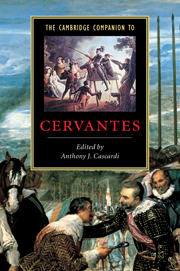Book contents
- Frontmatter
- 1 Introduction
- 2 The historical and social context
- 3 Cervantes and the Italian Renaissance
- 4 Don Quixote and the invention of the novel
- 5 The influence of Cervantes
- 6 Cervantes’ other fiction
- 7 Writings for the stage
- 8 Humor and violence in Cervantes
- 9 Psyche and gender in Cervantes
- 10 Cervantes and the New World
- Appendix: electronic editions and scholarly resources
- Index
- Series List
1 - Introduction
Published online by Cambridge University Press: 28 May 2006
- Frontmatter
- 1 Introduction
- 2 The historical and social context
- 3 Cervantes and the Italian Renaissance
- 4 Don Quixote and the invention of the novel
- 5 The influence of Cervantes
- 6 Cervantes’ other fiction
- 7 Writings for the stage
- 8 Humor and violence in Cervantes
- 9 Psyche and gender in Cervantes
- 10 Cervantes and the New World
- Appendix: electronic editions and scholarly resources
- Index
- Series List
Summary
A colleague once remarked, half in jest, that prevailing impressions of Spanish culture in the English-speaking world are dominated by two images: Don Quixote and the Spanish Inquisition. The image of the Inquisition has been reinforced from many angles, not least among which is a Monty Python comedy routine wherein absurdly garbed Inquisitorial figures issue strings of mock-harsh injunctions but manage only to stumble over their own commands. The matter of Don Quixote is, to say the least, more challenging. It is the case of a wonderfully complex and beguiling text that has become reduced in the popular mind to the pencil-thin profile of its principal character, an errant knight of La Mancha seen tilting at windmills or towering precariously over his paunchy squire. As for Cervantes, we are faced with an author whose identity has become similarly reduced, either to this single text or, less frequently, to a sole physical mark - the hand that was maimed by gunfire in the battle of Lepanto. Miguel de Cervantes Saavedra, “The Man Maimed at Lepanto” (“El Manco de Lepanto”), author of Don Quixote. Whether in spite of or because of these reductive encapsulations, images of Don Quixote the character, Cervantes the author, and Don Quixote the text have spawned a range of successors that are nearly impossible to characterize, from Flaubert's “female Quixote,” Madame Bovary, to the pop idealism of the 1965 Broadway musical, Man of La Mancha, and from the richly orchestrated tone-poem by Richard Strauss, Don Quixote, to the infinitely subtle variations of Borges' most famous text, now also massively consumed, “Pierre Menard, Author of the 'Quixote.'”
- Type
- Chapter
- Information
- The Cambridge Companion to Cervantes , pp. 1 - 10Publisher: Cambridge University PressPrint publication year: 2002
- 1
- Cited by



